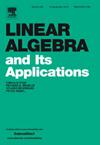具有很少距离特征值的无限一族积分和距离积分Cayley图
IF 1.1
3区 数学
Q1 MATHEMATICS
引用次数: 0
摘要
本文利用群的中心积的概念,构造了泡利群的Cayley图的距离矩阵,并递归地定义了泡利群。这些Cayley图构成了具有积分邻接谱的3n+2次正则非距离正则图的无穷序列{Γn}n≥1。我们显式地确定了所有的距离特征向量和特征值,表明每个图都有六个不同的距离特征值,回答了Atik和Panigrahi的问题。而且,所有的距离特征值都具有显著的整数性质。我们计算每个图的直径和以任意顶点为中心的所有球体的基数。我们还可以确定拓扑指数,比如维纳指数,维纳极性指数,哈里指数,以及距离能量。我们最后证明了Cayley图序列是Aouchiche和Hansen提出的两个猜想的反例。本文章由计算机程序翻译,如有差异,请以英文原文为准。
On an infinite family of integral and distance integral Cayley graphs with few distance eigenvalues
We construct the distance matrices of the Cayley graphs of the Pauli groups, recursively defined by using the notion of central product of groups, with respect to a suitable symmetric generating set. These Cayley graphs constitute an infinite sequence of regular non distance-regular graphs of degree with integral adjacency spectrum. We explicitly determine all the distance eigenvectors and eigenvalues, showing that each of these graphs has exactly six distinct distance eigenvalues, answering a question by Atik and Panigrahi. Moreover, all the distance eigenvalues have the remarkable property of being integers. We compute the diameter of each graph and the cardinality of all spheres centered at any vertex. We are also able to determine topological indices like the Wiener index, the Wiener polarity index, the Harary index, as well as the distance energy. We finally show that this sequence of Cayley graphs is a counterexample to two conjectures formulated by Aouchiche and Hansen.
求助全文
通过发布文献求助,成功后即可免费获取论文全文。
去求助
来源期刊
CiteScore
2.20
自引率
9.10%
发文量
333
审稿时长
13.8 months
期刊介绍:
Linear Algebra and its Applications publishes articles that contribute new information or new insights to matrix theory and finite dimensional linear algebra in their algebraic, arithmetic, combinatorial, geometric, or numerical aspects. It also publishes articles that give significant applications of matrix theory or linear algebra to other branches of mathematics and to other sciences. Articles that provide new information or perspectives on the historical development of matrix theory and linear algebra are also welcome. Expository articles which can serve as an introduction to a subject for workers in related areas and which bring one to the frontiers of research are encouraged. Reviews of books are published occasionally as are conference reports that provide an historical record of major meetings on matrix theory and linear algebra.

 求助内容:
求助内容: 应助结果提醒方式:
应助结果提醒方式:


